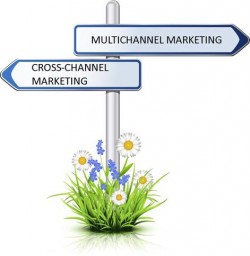- Category: February 2013 - Multichannel-Marketing
 Len Shneyder, Product Marketing Manager at IBM posted good definitions on Multi Channel and Cross Channel Marketing on his company’s blog Smarter Commerce, where he explained in detail that both terms are not interchangeable, but actually even significantly different concepts.
Len Shneyder, Product Marketing Manager at IBM posted good definitions on Multi Channel and Cross Channel Marketing on his company’s blog Smarter Commerce, where he explained in detail that both terms are not interchangeable, but actually even significantly different concepts.
He defines Multi-Channel Marketing as creating and launching campaigns across multiple channels - for instance, sending out the same message to an audience via email, direct mail, or SMS, etc. The channels work independently and are generally not coordinated, but more of a silo approach or as Len says, it’s a “straightforward recycling of identical content across channels”.
Cross-Channel Marketing Len defines as the creation and promulgation of campaigns that take into account customer preferences and engage recipients on their chosen platform and via their preferred medium. It means that you are still using multiple marketing channels but you're taking a much more choreographed, orchestrated, personalized approach. One message reinforces the next message and leverages the benefits of the specific channel by driving your audience to action, as opposed to just repeating the same message. It's much more tightly integrated and looks at the interactions 'holistically' - not only how the customer is receiving the communication, but also how they're responding to it, he said.
Len writes: “Ask yourself, did you just show concern and understanding for your customer’s needs or did you show them you have no clue what platform, device and method of engagement they prefer? I’d venture to say the latter, not to mention you spent unnecessary money sending paper when digital would’ve sufficed. Also, did you happen to see if the consumer preferred SMS? No? Well that also incurs a higher cost than leveraging Facebook, Twitter, Google+ and cost effective email.”
Further, he believes, that channel utility is an important consideration when creating a messaging plan that is truly cross-channel, saying: “Mobile users tend to scan emails on their mobile devices and get back to them later on a laptop or click on them in moments of downtime. Twitter moves very quickly, take advantage of that medium by creating more compelling, time-sensitive offers that will encourage careful monitoring of the channel by customers—like a native scarcity factor. Facebook is driven by quality offers linked to images that help them stand out from the clutter of a given wall or news feed. By learning the preferences of your customers and measuring the impact of each channel you’ll be able to determine the number of touch points required to attract and sustain a customer’s interest without exhausting them through over zealous campaigning. Remember, less is more.”
Determining the right channel for your messages is extremely important, so you have to be aware that you can’t be all things to everyone. But what you can do is offering the right thing to the right person. Engage your customers across the channels and mode of communication they request through either spoken or unspoken actions that you determine based on observing their browsing and buying habits.
“It may take a leap of faith to turn down your messaging fire hose but chances are that when you do you will find your audience is more attenuated to what you have to say, rather than avoiding too much of the same thing”, Len concludes.
By MediaBUZZ


